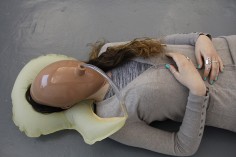Isoculture
CO2 capture sleep mask
source: burtonnittacouk
A sleeping mask designed to capture CO2 whilst inhabitants sleep to moderate the life support system of the Isoculture. The CO2 is captured into crystal form within the pillow.
.
.
.
.
.
.
.
source: burtonnittacouk
Imagine a city of the future isolated from the wider environment where humans become self-sustaining.
Food, energy, medicine, for example, is derived from human origin and man-made biological systems.
Outside of the Isoculture city the environment will become a ‘no-mans’ land to help it recover from widespread human impact.
In terms of their presence on the planet – humans aim to disappear.
The Isoculture project embraces future science & technology and prompts changes to our self-perception to redesign our human world. And by artificially recreating and updating the natural world, we understand and value our current relationship within the ecosystem on profound new levels.
Ultimately, underpinning the project is the question of whether it’s possible for humans to live in isolation. As such, the Isoculture prepares humans for unknown future challenges such as to live in hostile environments, a time of great biodiversity extinction, or maybe for life on another planet. Inhabitants seal off the city so not to encroach further on the surrounding environment.
Welcome to the Isoculture.
The project was initiated by Michael Burton and Michiko Nitta who posed the question:
Could humans ever live in a truly self-sustaining system, which is isolated from the wider environment?
.
.
.
.
.
.
.
source: cargocollective
Isoculture is a project driven by MA Design Interaction graduates from Royal College of Arts, Michael Burton and Michiko Nitta. The concept of Isoculture is to question the possibility for humans to live in isolation without making any contacts with other species. As such, it is believed that the Isoculture prepares humans for unknown future challenges such as to live in hostile environments, a time of great biodiversity extinction, or maybe for life on another planet.
The personal take on Isoculture was to transform the idea into a narrative of 2 scientists who invented a post-human creature called Teras 0.1 who were evacuated to an extraterrestrial isolated environment due to the disruption of earth. Due to its similarity to humans’ brain, Teras’ preliminary ecosystem was inside a laboratory jar filled with a gelatine-like substance. Therefore, a video installation emphasizing Teras’ vision whilst living inside the jar became the main subject of the video. The video was projected onto the wall painted by blackboard paint to simulate the scientist’s working environment.


